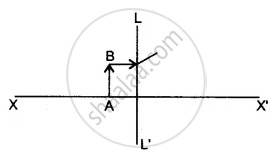Advertisements
Advertisements
प्रश्न
An object of height 4 cm is placed at a distance of 15 cm in front of a concave lens of power, −10 dioptres. Find the size of the image.
उत्तर
Object distance u = -15 cm
Height of object h = 4 cm
Power of the lens p = -10 dioptres
Height of image h' = ?
Image distance v = ?
Focal length of the lens f = ?
We know that:
`p=1/f`
`f=1/p`
⇒`f=1/-10`
⇒ `f=-0.1m =-10 cm`
From the lens formula, we have:
`1/v-1/u=1/f`
`1/v-1/-15=1/-10`
⇒`1/v+1/15=-1/10`
⇒`1/v=-1/15-1/10`
⇒`1/v=(-2-3)/30`
⇒`1/v=-5/30`
⇒`1/v=-1/6`
⇒`v=-6` cm
Thus, the image will be formed at a distance of 6 cm and in front of the mirror.
Now, magnification m =`v/u=(h')/h`
or `(-6)/(-15)=(h')/4`
`h'=(6x4)/15`
`h'=24/15`
∴`h'=1.6 cm`
APPEARS IN
संबंधित प्रश्न
What does sign of power (+ve or –ve) indicate?
What is the power of a convex lens of focal length 0.5 m?
A lens has a focal length of, −10 cm. What is the power of the lens and what is its nature?
Define the term focal length of a lens.
State the condition for the following a lens has both its focal lengths equal .
A double convex lens has two surfaces of equal radii R and refractive index \[m = 1 \cdot 5\]
Complete the diagram to show the formation of the image of the object AB.

(i) Name the Lens LL’.
(ii) Where is the image of the object AB formed?
(iii) State three characteristics of the image.
What is power of accommodation of eye?
An object is placed in front of a converging lens. Obtain the conditions under which the magnification produced by the lens is
- negative and
- positive.
